Anderson and Muncie
Ball State University
Forecasting is an exercise fraught with risk, and that risk doubles with forecasting the performance of small-sized urban economies. Not only are the data that we use to assess and project the future for smaller metro areas of uncertain quality, the comparatively small geographies involved also make it possible for one or two unforeseen events to undo even the best efforts at prediction.
But the businesses, governments, and families in Anderson and Muncie are nonetheless more concerned than most about the future of their economies. Since the mid-1990s, both of these communities—as well as neighboring Kokomo and Richmond—have seen stagnation and decline, as transition in the manufacturing economy continues to erode their economic base.
The past year (2006) saw several dramatic announcements of new investment and significant projected employment gains for both Anderson and Muncie. Unfortunately, those announcements were offset by negative developments in several established manufacturing companies. The upshot is that the slow declines in employment that have occurred during most of the last decade are likely to continue in 2007.
Anderson
The Anderson metro (Madison County) was reborn after the 2000 Census, after spending a decade as part of the Indianapolis (now Indianapolis–Carmel) metro area. That means that very current estimates of employment by major industry are available from the Current Employment Survey (CES), the same source for state and national level payroll employment estimates. Those data portray the Anderson economy as having stabilized in 2006 from the job declines suffered in previous years.
In the first three quarters of 2006, employment averaged about 100 jobs, or 0.2 percent, higher than the same period in 2005. That stability was largely due to a 300‑job increase officially estimated for Madison County manufacturing employers. This 4.7 percent growth in factory jobs, if it survives the coming revisions, would eclipse the manufacturing job growth of every other metro area in Indiana over the same period.
Unfortunately, the CES employment estimates are almost certainly too high. A comparison of recent quarterly growth to the UI-based Quarterly Census of Employment and Wages employment estimates, shown in Figure 1, reveals a considerable disagreement between the two growth estimates since the midpoint of last year. The QCEW data, available only through March 2006 at the time of this writing, will form the basis for revisions due in February 2007.
Figure 1
Percent Change in Total Employment from Last Year, Anderson MSA
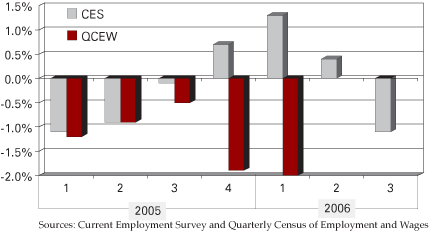
The data disagreement is particularly noticeable for Anderson’s manufacturing employers. The CES data shown in Figure 2 portray a mild rebound in goods production employment in 2006, whereas the less timely, but more reliable QCEW data show sizable job declines continued into the first three months of the year.
Given the declines in building activity, and the increase in filings for claims for unemployment insurance, our assessment is that Anderson’s job base has continued to decline in 2006.
Figure 2
Percent Change in Manufacturing Employment from Last Year, Anderson MSA
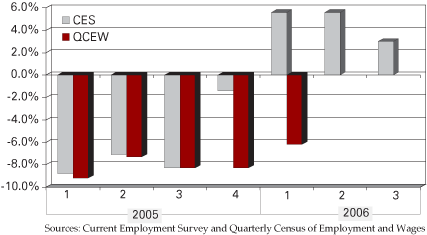
The $359 million investment by Nestlé in a food processing facility in Anderson is welcome news to this hard-pressed community. The company will employ at least 300 workers on a 190-acre site beginning in early 2008. The Flagship Enterprise Center, a partnership between the city and Anderson University, has continued to land new businesses, most lately in emerging energy technologies.
But with the announced closure of Guide (1,325 jobs) and the likely sale or closure of bankrupt-Delphi’s last Anderson factory (700 jobs), the preponderance of economic news remains bad for this hard-hit community. We project employment declines of approximately 2 percent for 2007.
Muncie
The recent declines in payroll employment in the Muncie metro (Delaware County) have softened only slightly in 2006, as depicted in Figure 3. With a decline in employment of 1 percent in the Muncie metro through September, it ranked second to last among Indiana metros, exceeded only by Kokomo, as ranked by the CES data. Certainly the long-anticipated closure of the manual transmission facility, once jointly operated by General Motors and Chrysler, contributed to the decline.
Figure 3
Percent Change in Total Employment from Last Year, Muncie
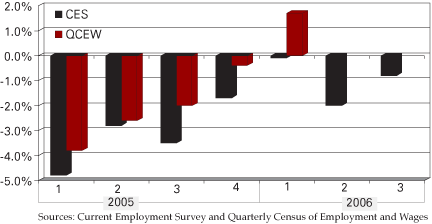
Meanwhile, the QCEW employment data are a bit more optimistic. Muncie’s CES-reported job decline in the first quarter of 2006 is depicted as a gain in the QCEW data, and earlier quarterly losses are similarly less harsh. That first quarter gain in the QCEW reported employment is particularly heartening when considering the manufacturing job loss shown for the same period (see Figure 4).
Figure 4
Percent Change in Manufacturing Employment from Last Year, Muncie
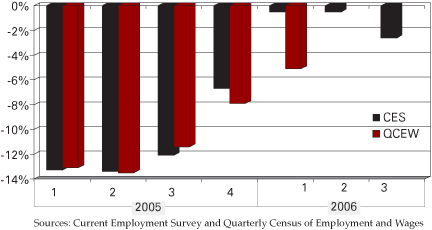
Although building permits are down from last year, unemployment claims through November are running at levels comparable to 2005. Based on the incomplete information available, our assessment is that Muncie’s employment declines have leveled off.
The outlook for 2007 is clouded by the uncertainty over the status of Borg-Warner’s transfer case manufacturing facility on the city’s west side, which the company has threatened to close unless the current labor contract is reopened and concessions are made. The facility’s product is closely linked to Ford truck sales, which have suffered greatly in recent months.
However, the opening of a 700-worker Sallie Mae loan processing center in Muncie and the ground breaking of a $120 million expansion and renovation project at Ball Memorial Hospital, as well as other developments, have raised hopes that any job losses can be offset by gains elsewhere in the economy. Our projection calls for very modest growth in Muncie’s job base in 2007, amounting for approximately 200 net new jobs, or about 0.4 percent.
Facts about Madison and Delaware Counties
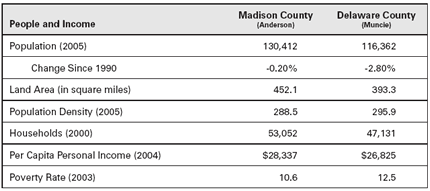
Also in this Issue…
- Outlook for 2007
- The International Economy
- The U.S. Economy
- Financial Forecast
- Housing
- Indiana Agriculture
- Indiana
- Anderson and Muncie
- Bloomington
- Columbus
- Evansville
- Fort Wayne
- Gary
- Indianapolis
- Kokomo
- New Albany
- Richmond
- South Bend and Elkhart-Goshen
- Terre Haute
- Indiana Metro Economies at a Glance
- Return to Table of Contents



